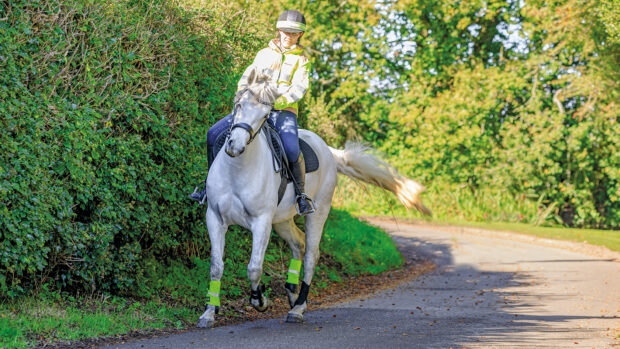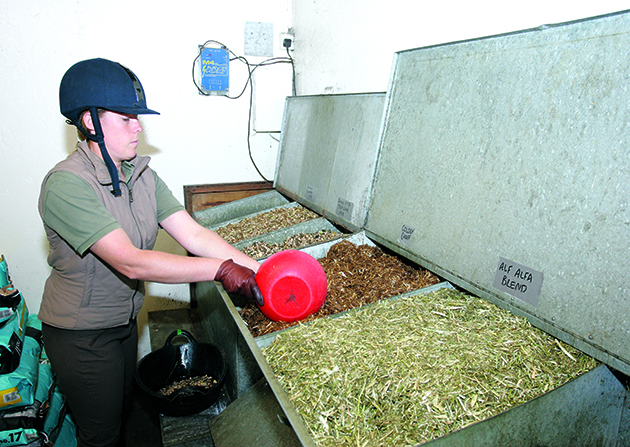Everyone knows there is no one way to manage a horse – especially when there are so many factors that go into creating his care programme. What’s more, every horse is an individual with his own specific needs, considerations and health concerns. While it would be helpful if horses produced a list of their wants and needs, it’s up to us owners to work it out and tailor management as best we can. This is why feeding a horse with no energy is a real head-scratcher – the underlying cause could be one of many.
Horse with no energy: why is my horse tired?
A horse lacking in energy typically performs below his best. He might drop behind the leg frequently, lack his usual impulsion or precision or accumulate more jumping faults than normal. A lack of energy may manifest in evasive behaviours such as napping or spooking. Or, you might notice he isn’t as alert on a hack, and doesn’t want to canter as frequently or as far. If you feel like you’re riding a horse with no energy, the following factors could be contributing:
We’ll explore each with an expert below. To jump to a specific topic, click on it above.
Soundness
A horse’s dip in performance and energy might be explained by checking his vital signs, says H&H veterinary consultant Karen Coumbe MRCVS.
“Your horse can’t tell you when he has a headache, but if you make a habit of observing him closely and knowing what’s normal, you’ll be best placed to pick up anything abnormal,” she explains. “Sometimes, lethargic horses have a low-grade virus. If you know his normal temperature range, you’ll know right away if he has a fever, so best to check.”
In cases where a horse has reduced energy, Karen recommends consulting a vet early.
“It helps if you have a regular vet who knows you and your horse and can see if there’s a difference,” Karen adds. “Get an independent assessment and a clinical exam, plus a blood test. A normal blood result can be reassuring.
“Classically, sore feet are the culprit, or low-grade lameness possibly linked as well to a sore back,” adds Karen, who recommends a full lameness work-up to help isolate the region from which the lameness originates if problems persist. Some horses will benefit from a change in shoeing or a simple saddle refit.
Horses that are persistently lethargic may require further investigations, such as checking out the horse’s heart to look for cardiac abnormalities sometimes including an electrocardiogram (ECG) or ruling out gastric ulcers by gastroscopy. The best thing is talk to your vet.
Workload
For British Showjumping accredited coach Christine Shubrook, a regular coach who knows you and your horse well – and is familiar with his routine and workload – could provide a helpful second opinion.
“You see a lot posts on Facebook asking ‘what should I feed my horse?’ But your coach sees you every week and knows you, and can look at the problem holistically.”
If you feel that your horse has no energy, Christine recommends being honest about how fit he really is.
“Because of the weather, the light and work commitments, it can be really hard to keep a horse going through winter.
“But whatever you want to do on the weekend, be it a fun ride or a round of showjumps, the level of work shouldn’t be a surprise to your horse. And really, fun rides can be three or four hours in length. Plus, you’ve got your travel there and back, where the horse has to balance himself for the whole journey. That in itself is tiring – you wouldn’t run a marathon on no training, after all!
“A round of showjumps is about two minutes, so your horse needs to be able to canter comfortably and regularly for two minutes in the school. It’s longer than you think, so use a free app to time yourself. That way, you know you’re putting in the right level of work.”
Christine says increasing your horse’s fitness now will pay dividends through the winter. What’s more, keeping his work varied throughout the darker months targets his whole body.
“Get him fit enough for a fun ride now and you can maintain it,” she says. “Not by riding that long distance, but by timing your canter work with walk intervals for recovery, doing simple lateral work to strengthen the core and walking over poles. Walking over poles in hand, especially raised ones, demands more than people realise. Just 20 minutes is quite an intense muscle-builder.
“It doesn’t need to be a complicated pattern – three poles in a line does a lot. It’s much easier to fit in than a hack and targets muscles more efficiently.”
Rider fitness is another factor that could hamper a horse’s performance.
“The fitter we are, the more we can support ourselves, the quicker we adapt to the horse’s movement and become an easier load for him to carry.”
Nutrition
According to Sarah Nelson BSc, product manager at Spillers, the way your horse looks should give you a good idea of whether his energy requirements are being met.
“Horses maintaining a healthy body weight or condition score are consuming the right amount of energy for their workload – regardless of whether they lack energy under saddle!” she says. “Unless they’re actively losing weight, overweight horses are consuming too much energy. Underweight horses are not consuming enough energy.
“Vitamins and minerals are needed for optimum health,” she adds. “Many are involved in energy metabolism which means a shortfall in the diet could result in lethargy. Make sure you are feeding the recommended amount of an appropriate compound feed or balancer to make up for any shortfall in winter forage.”
Sarah also advises owners to consider the type of energy that is most appropriate for their horses.
“Feeds high in cereal starch promote a more energetic response in some horses, which is why some owners choose traditional competition mixes or oats for those that are ‘lazy’ or in need of extra ‘sparkle’. Many healthy, exercised horses in ideal body condition handle controlled amounts of cereal starch in their diet very well. For those in moderate to hard work, a balance of energy sources, such as those found in Spillers Performance Mix, can help to support performance.
“However, diets high in starch and sugar are not suitable for all horses. Spillers Stamina+ Cubes are rich in highly digestible fibre and oil, providing a source of ‘slow release’ energy for horses in moderate work.”
Fuelling the good-doer
Overweight horses in need of an energy boost often get their spark back once they’ve lost weight, says Dengie senior nutritionist Dr Katie Williams PhD MSc (Dist) RNutr.
“It’s important to balance the diet,” she continues, “because it can often be the shortfall in vitamins and minerals, which are involved in energy metabolism, that can impact the energy levels.
“A classic one for the good doer would be the loss of electrolytes through sweat. Horses who carry a lot of weight are probably going to sweat more, because they work a bit harder, and the loss of electrolytes contributes to fatigue and them feeling like they are running out of active energy. Balancing the diet, and topping up electrolyte levels, is key to maintaining performance.”
Katie also recommends adding a quick-release energy source to a good doer’s bucket if he’s at a healthy weight.
“As long as he isn’t susceptible to laminitis or EMS, adding a traditional quick-release energy source, such as bruised oats, can help give him a bit of sparkle.”
Katie suggests adding a couple of handfuls to begin with, and seeing if that has the desired effect.
“First of all, you don’t want to add too much and end up with exuberance,” she explains, “and secondly, you don’t want to exceed around one-and-a-half kilos total weight per feed. Any more than that, and the risks of feeding higher starch outweigh the benefits of the quick-release energy it provides.
“It’s also key to remove the oats if the horse has time off.
“Feeding a few handfuls of oats alongside a balanced ration shouldn’t disrupt the overall calcium-to-phosphorus ratio. But, if you do end up feeding more, alfalfa is a really nice natural balancer for this. So, if you had a couple of scoops of Dengie Alfa-A Molasses Free and top dress with up to 1.5kg of oats, then this would naturally balance for calcium and phosphorous. However, if you feed even more, you will need a balancer or supplement to ensure all the micro-nutrient needs are met.”
If you’re looking to fuel a higher level of work and want to aid your horse’s stamina, an oil-based chopped fibre is Katie’s go to.
“Oil is a concentrated, dense source of slow-release energy,” explains Katie. “Which is really useful for helping to fuel low-intensity work. This means energy stored as glycogen in the horse’s muscles is spared – a so-called glycogen-sparing effect meaning they’ve got more in the tank when they move into more intense work. This effect also seems to help horses recover from exercise quicker.
“My go-to for this is Dengie Alfa-A Oil. It’s a really simple formulation but seems to do the job!”
Timing is key
For owners looking to feed a horse with no energy a ‘quick release’ energy source, when they feed it could be the answer. According to Topspec nutrition director Nicola Tyler BSc (Hons) RNutr: “Feeding strategically for a horse to be more in front of the leg is best done about an hour-and-a-half before you need them to have more oomph,” she advises. “This is particularly good advice for good doers. If you had a competition in the morning, you might feed 100g of a fast-releasing energy source, such as TopSpec Turbo Flakes, to a good doer. This won’t add significantly to the horse’s calorie intake, but it will give him a short-term energy boost.
“The effect lasts for about two hours before insulin levels rise and take down the level of glucose that you’ve increased in the bloodstream.”
- To stay up to date with all the breaking news throughout Horse of the Year Show, London International and more, subscribe to the Horse & Hound website
You may also be interested in:

Should you call time on feeding bran mash? Horse & Hound investigates…

5 expert tips for feeding horses this winter

The 10 golden rules of feeding horses

Subscribe to Horse & Hound magazine today – and enjoy unlimited website access all year round





